|
Taking the Plunge for Preservation
By Stephani Stephenson
September/October 2019
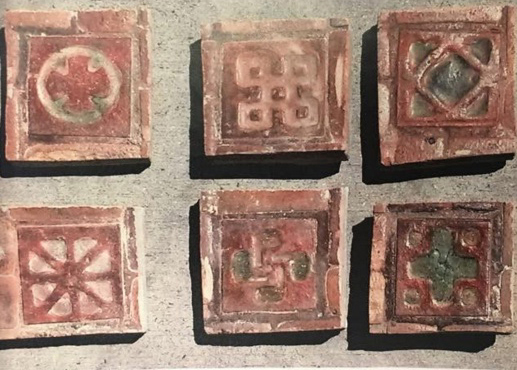 Only a handful of original Plunge tiles remain in existence. The contractor sent these to Stephani for her reference. |
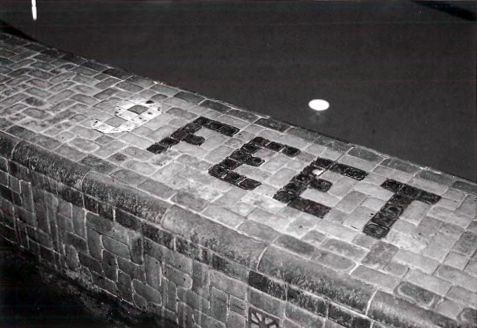 Detail of the Plunge's original tilework. Note the small decorative tile below the second "E" Square accent tiles like this one only appeared every 8 feet. |
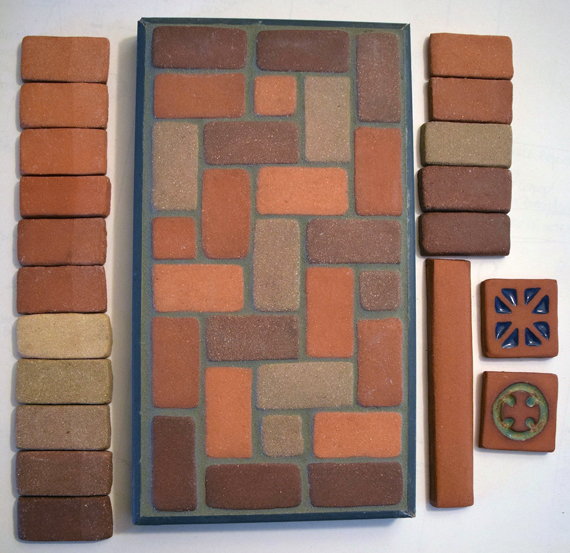 Stephani made these sample pavers to show the client how well she replicated the original tilework. |
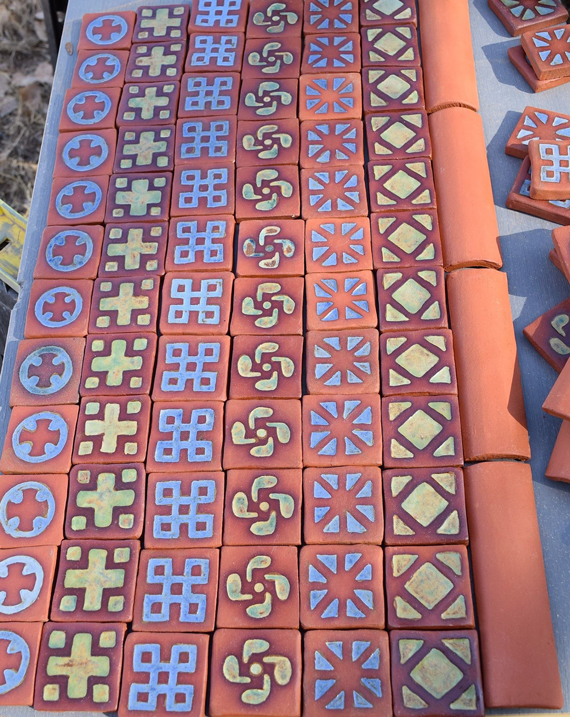 In her studio, Stephani laid out the 2"-square decorative tiles she made in a blaze of color, but each one was spaced every 8 feet when installed on the pool walls. |
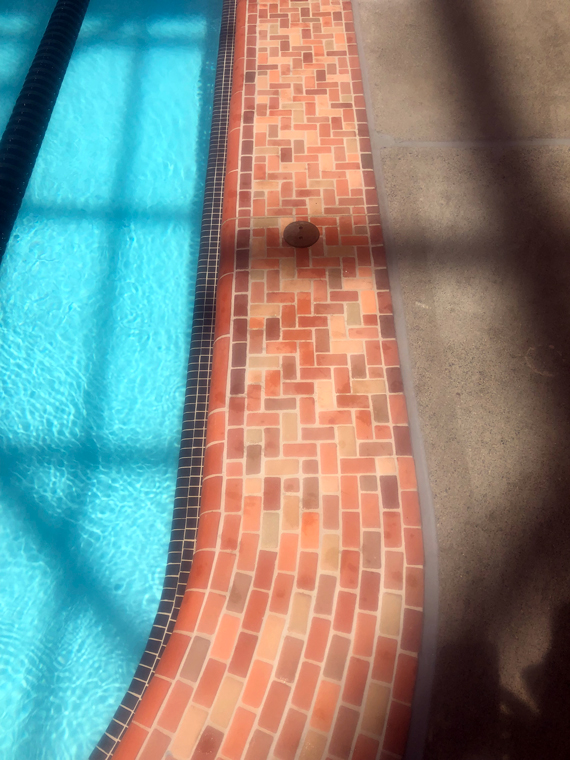 The finished project, with Stephani's tile hugging the pool's edge. Photo by Tim Lowry |
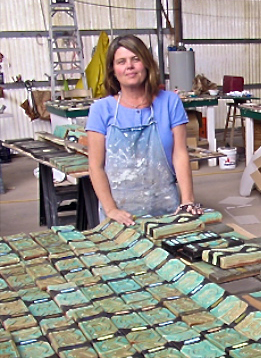 Tile artist Stephani Stephenson in her old Encinitas studio several years ago. She now lives and works in St. David, Arizona. |
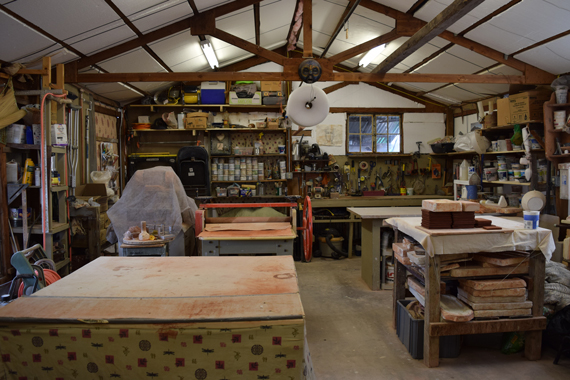 Stephenson's studio in St. David.
All photos above courtesy Stephani Stephenson, except where noted otherwise. |
Editor's note: For decades, SOHO has been fighting to save the 1925 Mission Beach Plunge, originally a salt-water swimming pool, from demolition in Belmont Park. The pool's building closed in 2014 due to corrosion that rendered the iron frame unsafe, and demolition of the entire structure except the pool followed. As plans were made to enclose the pool with a new airy, glass-and-aluminum-frame pavilion with a retractable roof, SOHO advocated for replicating the pool's original Batchelder-type tile, and the City of San Diego Historical Resources Board officially concurred. SOHO also recommended tile artist Stephani Stevenson of Revival Arts Studio to the City, which owns the building, for the enormous job of recreating by hand more than 40,700 tiles in and around the 60' x 175' pool. She got the job, her largest to date for a public space, and partnered with Syzygy Tile in Silver City, New Mexico to meet a production deadline of just four months. A long-time SOHO member, Stephenson is widely known for her technical knowledge of Batchelder and Claycraft tile and her artistic ability to replicate the look and feel of their glazes and textures. She founded Revival Arts Studio in 2002 in North County, and now lives and works in St. David, Arizona, as a tile maker and sculptor.
When I got a call inquiring about supplying reproduction tiles for the Mission Beach Plunge Pool renovation in 2015, the original 1920s era tile had been removed and disposed of. Pacifica Enterprises, the contractor, sent me historical images of the Plunge and a few salvaged tiles, in very poor condition. I immediately recognized them as Batchelder- or Claycraft-type small pavers, trim, and decorative accent tiles.
Then, in 2017, project consultant Jennifer Ayala, of Nexus Planning and Research in San Diego, sought me out as a resource on technical and historical aspects of Craftsman tile. She became the helpful liaison between the City, contractor, and me.
The original Craftsman tile makers used native Southern California clay deposits and fired tiles in fossil-fuel burning kilns that created a spectrum of subtle tones from just a few clays. By now, the old clay pits are long since paved over, and clay and glaze materials have changed in the ensuing 100 years. Many tile makers today use electric kilns, which do not impart the same tonal variation as gas-, oil-, or wood-fired kilns. I knew I would need to replicate the variations intentionally.
I stressed to Ayala that the replicated tile would not match the originals, but that I would use the same processes employed in the 1920s. My cleaner, crisper-looking tile would be made from moist clay and either hand pressed into plaster molds or, in the case of the pool's edge trim, extruded by hand. For color variants, I added iron and copper to the clay. Having worked with clay for 35 years and studied and reproduced this genre of tile for nearly 20 years, I felt confident I could provide tile with the warmth and authenticity of the original.
In addition to my own tests, these tiles had to meet technical requirements for strength, moisture absorption, and freeze-thaw variations. Later, the City and contractor tested for durability, slip resistance and the effects of pool chemicals.
All this took place before my Revival Arts Studio bid was selected for the job, which happened in July 2018. The tile patterns and placement would follow the original layout. We'd need more than 37,000 finished pieces of 1" x 2" tile; 2,000 pieces of 1" x 1"; 1,600 pieces of 6" trim; and about 100 2" x 2" decorative tiles. We preassembled sections that called for a herringbone pattern, which greatly reduced time and labor during onsite installation.
The revitalized pool opened on July 4, 2019. Read about it HERE.
When I saw photos of the finished project, I was astonished to realize that the pool tile—both the white hexagons in the pool itself and the band of earthen-toned mini pavers around the perimeter—were the only real reminders of the popular 1920s Mission Beach Plunge. Everything else was thoroughly 21st century. I felt that the warm-colored tile surrounding the pool was exactly what that gleaming new space needed, aesthetically and historically. I am honored and proud that Revival Arts Studio, with Syzygy Tile of Silver City, New Mexico, contributed high-quality tile to this project in the Arts and Crafts tradition of regional American studios.
|
2025
2024
2023
2022
2021
2020
2019
2018
2017
2016
2015
|










